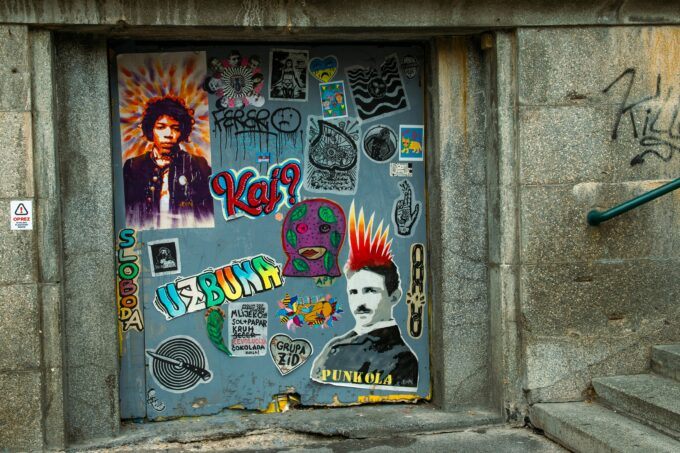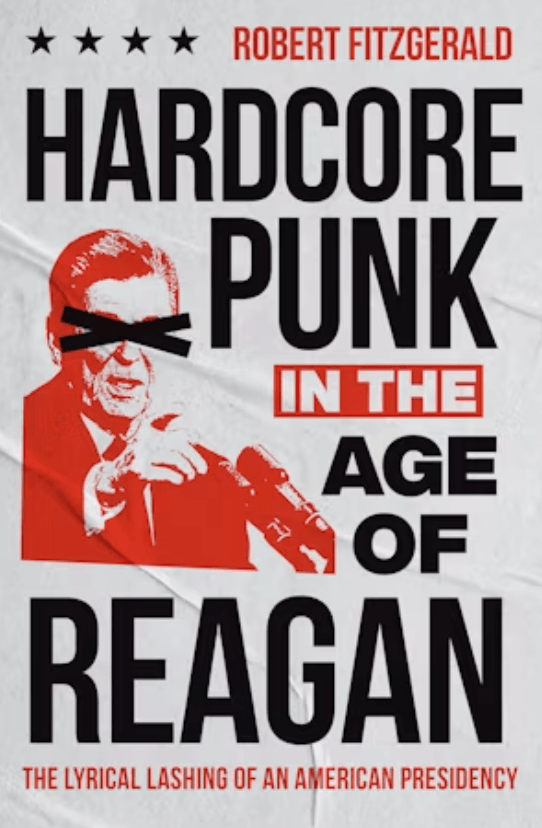
Image by Caz Hayek.
I was never a huge fan of hardcore punk music. That being said, I have seen dozens if not hundreds of punk shows. From Vancouver, BC’s DOA to Washington, DC’s Bad Brains, I long ago lost count of the number of hours I underwent aural assaults in venues the size of a bedroom to outdoor amphitheaters. If someone were to ask why, the answer is simple. Punk was the cheapest and most common live music around during the years I am writing about: 1977-1986. This was especially true in the San Francisco Bay Area. Furthermore, it was usually the most overtly political of the music around. Of course, that was left and anarchist politics. Elsewhere in the nation there were several other bands making a mark and gaining a following in the cities and towns from which they sprang.
Given that I was living in the streets, renting in apartments and crashing on couches in Berkeley, Oakland and San Francisco, the bands I ran into the most were local bands. The Dead Kennedys were foremost among them. I was friends with a guy who did sound for the band for a couple years. He was a yippie I met at a giant Grateful Dead concert in 1977 in New Jersey. We both split the east coast around the same time, ran into each other at the White Panther/Earth Peoples Park house in west Berkeley in January 1978 where a friend and I were crashing. I would see him at shows, festivals, street fairs, parties and on the street; we both watched and conversed about the scene as it slowly transitioned from a hippie freak culture to punk. We always had a good time sharing ideas, various chemicals and tall tales. Anyhow, he always got me into the Dead Kennedys shows and pretty much any other show I wanted to see at the North Beach punk palace Mabuhay Gardens. Another venue that hosted a lot of punk bands was up the street from an apartment a group of friends and I shared on Berkeley’s Dwight Way. It was a student co-op called Barrington Hall; it has its own legends. I saw many bands there; the ones I remember best are Black Flag and the Stranglers. It was at the latter show when my short-haired punk friends rescued me from some mean motherfuckers who wanted to kick my long-haired ass.
Anyhow, I digress. While I was hearing all the San Francisco and Los Angeles Bands, my east coast friends were seeing bands like Minor Threat and Bad Brains. Black Flag was blasting eardrums and California redneck psyches in Orange County not far from where Richard Nixon was whiling away his taxpayer-paid retirement. Then there were bands I had never heard rocking against the right wingers in Ohio, Texas and elsewhere in the vast wasteland that US residents call the midwest. A band from Seattle, Washington called the Fartz had a great little tune called “The Battle Hymn of Ronnie Reagan” set to the tune of “The Battle Hymn of the Republic.” Suffice it to say it wasn’t cheering on the one nation under Reagan. One band from Texas did get my notice, but not until they moved to the Bay Area. They called themselves The Dicks and it was their song called “Anti-Klan” that caught my attention when I heard it blasting from a window on the corner of Haight Street and Masonic Street—right above Uganda Liquors. The singer Gary Floyd makes the connection between the Klan and the cops crystal clear. Author Robert Fitzgerald describes The Dicks lyrical content like this in his new book Hardcore Punk in the Age of Reagan: The Lyrical Lashing of an American Presidency: “they made targeting Nazis, the Klan and racist police central to their songwriting throughout their career.” (154) Any band that did that had my attention.
Fitzgerald, who is described as the assistant principal of the Thomas Metcalf Laboratory School in his bio on the book’s back cover, is a lifelong fan of punk. His book discusses a plethora of punk bands and musicians that came and went during the year Ronald Reagan squatted in the White House, making America great again the first time around. At times little more than a catalog of bands and their anti-establishment lyrics, when considered in its entirety Hardcore Punk in the Age of Reagan becomes a unique and important history of the hard turn to the right in the United States of the 1980s. More importantly, at least in my mind, is that it is also a history of a rebellion against that turn by many of the nation’s youth; a rebellion founded in and defined by its music and the subculture that developed around it.
Fitzgerald divides the book into chapters that encompass the major political foci of the decade. In doing this, he describes the central elements of the Reagan counterrevolution: nuclear proliferation, the US counterinsurgency in Central America, the resurgence of the racist right, the brutality of the police, the rise of the religious right and the accompanying heterosexism and homophobia, and the intentional impoverishment of America’s already marginalized populations. In his discussion, Fitzgerald bounces the reader around the country, introducing bands and their music; bands and their local scenes. He looks at the lyrics and remarks on their delivery by the bands that wrote them. Reflecting on the lyrics, he points out their power and their inconsistencies, especially those that comment on the innate racism white residents of the US often (if not always) seem to hold. In the chapter titled “Police Story” which is about police brutality, police overreach and police power, the author points out that punks were calling out and going after the cops in their songs years before hiphop groups like NWA and Body Count. Of course, it was the hiphop artists who were attacked by the media and the police union (who were most likely feeding the media its stories). In part, this was because the reach of the rap songs was much greater than that experienced by the hardcore bands. However, it’s a fairly obvious statement to make that it was the hiphop genre’s identity as the music of Black people that truly brought the wrath of the police down on them. It’s not that the cops didn’t come down on the punk bands and their fans, they just came down harder on the rap musicians and their scene. After all, US cops have plenty of practice in going after African-Americans.
Hardcore Punk in the Age of Reagan is a great introduction to the world of hardcore punk in the 1980s. It is also a less-than-gentle reminder that Ronald Reagan was not much different than Donald Trump is today—a less loutish Trump, if you will. I heartily recommend reading it with a device that streams music within reach. That way, if there’s a song you don’t know or aren’t sure you remember, chances are you can find it in the internet ether and turn it up. LOUD, of course.
The post Punks Against Reagan, Racism, War and the Religious Right appeared first on CounterPunch.org.
This post was originally published on CounterPunch.org.